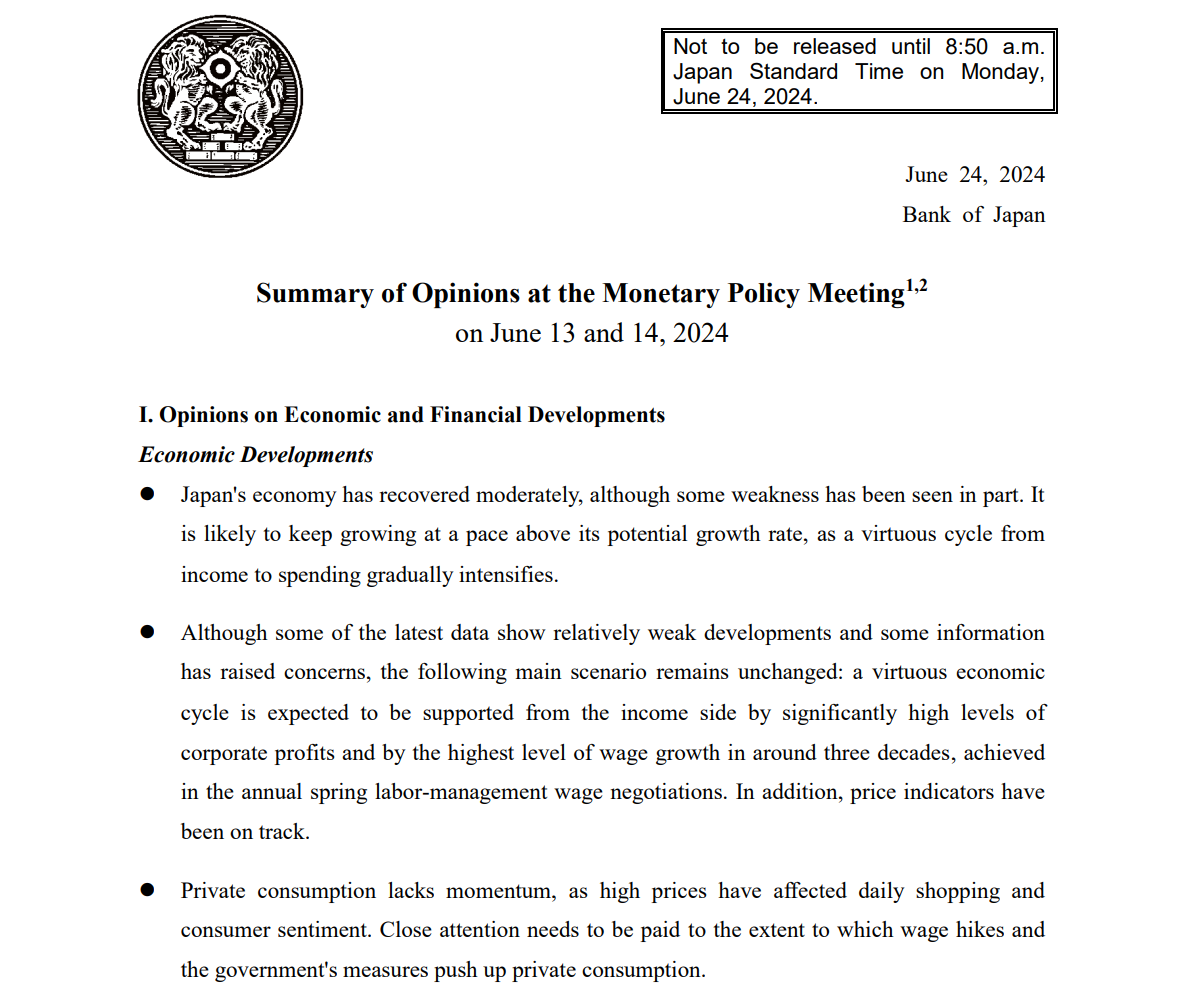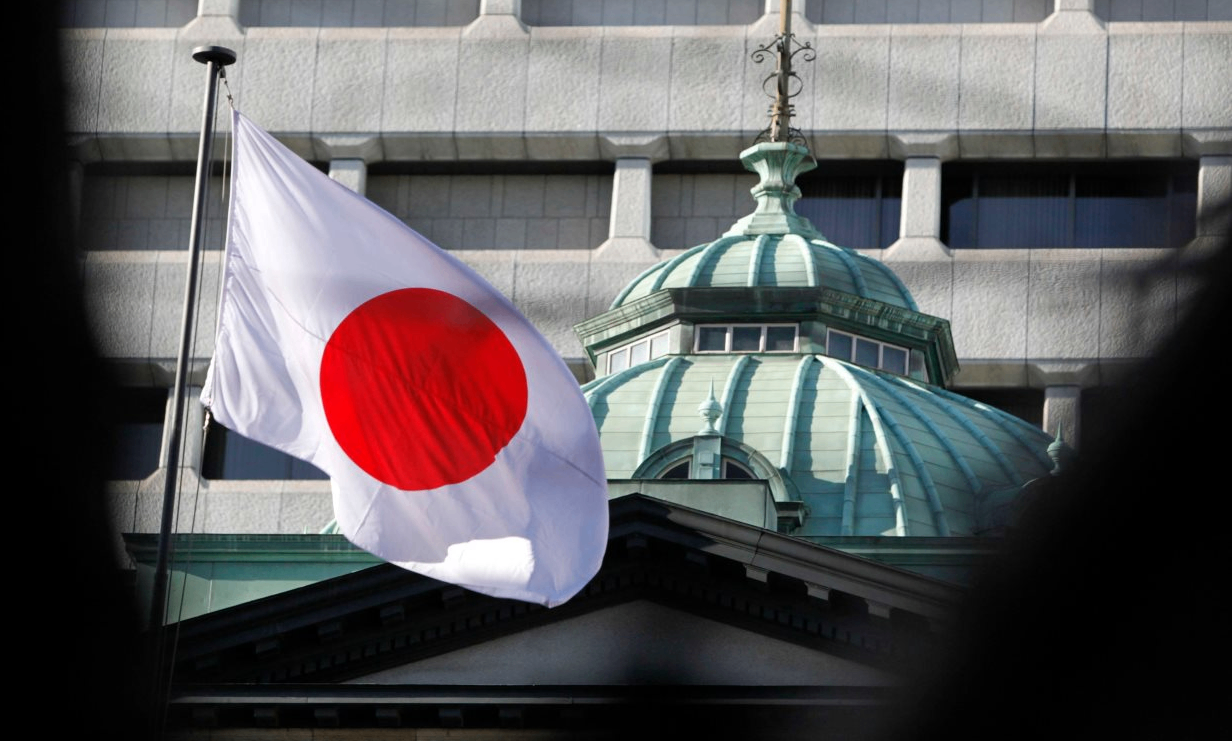Summary of the BOJ's June meeting released, interest rate hike expectations have risen
According to the summary, a member of the central bank's board of directors stated that if the basic inflation rate rises, the central bank will raise policy interest rates and adjust the degree of monetary easing.
On Monday (June 24), Japanese authorities released a summary of opinions from the June policy meeting.。

● About rate hikes
The summary mentions that although a virtuous cycle is forming between wages and prices, considering nominal wage growth rates, inflation expectations, service price growth rates, and other factors, the basic inflation rate has not yet reached 2%.
There are still some differences among the nine board members of the Bank of Japan regarding whether it will raise interest rates.Summary: A member of the central bank's board of directors stated that if the basic inflation rate rises, the central bank will raise policy interest rates and adjust the degree of monetary easing.
Another committee member pointed out that the risk of rising prices has become more apparent. "Considering that the risk of rising prices has affected consumer sentiment, it is necessary for the central bank to continue closely monitoring relevant data in preparation for the next monetary policy meeting." The committee member said, "If deemed appropriate, the central bank should promptly raise policy interest rates to cope with the increased likelihood of achieving the target."
There are also opinions from the pigeon faction. Some members believe that only when economic indicators confirm that the inflation rate of the consumer price index has clearly begun to rebound, and medium - to long-term inflation expectations have risen, can policy interest rates be considered for change.
Regarding this, Ryutaro Kono, Chief Japanese Economist at BNP Paribas, wrote in a research report: "The risk of the Bank of Japan raising interest rates in July may be higher than initially expected."
● About the depreciation of the yen
The summary mentions that the depreciation of the yen increases the likelihood of an upward revision in the inflation outlook.
Some members believe that the development of exchange rates has a broad impact on economic activities, and if exchange rates continue to deviate from fundamentals, it will also affect the healthy development of the national economy. On the other hand, due to the fact that monetary policy not only affects exchange rates, but also affects various aspects of people's daily life and economic activities, it must be based on the overall situation of economic activity and price development.
Another member also had a similar view: "Monetary policy is formulated based on evaluating price trends and the development of basic wages. Monetary policy is not determined by short-term changes in foreign exchange rates."
Recently, the exchange rate of USD/JPY has once again approached the critical level of 160, sparking concerns in the market about Japanese authorities intervening in the foreign exchange market.
Now, the market generally believes that the USD/JPY exchange rate at 160 is an important intervention threshold for the Japanese authorities. The Japanese authorities spent a total of 9.8 trillion yen on currency intervention from April 26 to May 29. This intervention directly exceeds the total amount of funds spent on all intervention actions in Japan in 2022 (9.2 trillion yen).
IG Australia market analyst Tony Sycamore wrote, "We speculate that the next round of intervention by the Bank of Japan is likely after the USD/JPY triggers buy orders and breaks through the high of around 160.20 at the end of April." He stated that the reason for the yen's decline against the US dollar last week was due to stronger than expected data from the US Purchasing Managers Index and the Bank of Japan's reluctance to provide detailed plans to reduce bond purchases.
Ryutaro Kono believes that if the yen accelerates its significant decline, the Bank of Japan may take action next month.
On Monday, Masato Kanda, the highest official in Japan's foreign exchange affairs, responded by saying that he knew the yen's drop to around 160 had raised market vigilance towards intervention, but he pointed out that the authorities did not have a specific plan for when to intervene.

●About reduce the purchase of treasury bond
Let's look at the relevant views on purchasing treasury bond in the summary.
Earlier, at the monetary policy meeting in June, the Bank of Japan said that it would gradually reduce the size of treasury bond bond purchases in the future, and the specific reduction plan would be decided at the next meeting. It is understood that at present, the Bank of Japan purchases about 6 trillion yen of treasury bond every month, and its total holdings are about half of the total treasury bond.
As for the scale of treasury bond reduction in Japan, in the latest summary of the meeting, most members believed that caution should prevail.
A member said that when reducing the purchase of Japanese treasury bond, it is necessary to discuss the new market structure from a Medium to Long Term Plan, taking into account the holding structure of Japanese treasury bond in the future.
This coincides with the view of another member, who believes that it is better to formulate a medium-term plan before reducing the purchase of Japanese treasury bond, and this plan should take into account the supply and demand situation and the improvement of the bond market function. At the same time, as it is necessary to determine the optimal reduction rate, the central bank should also spend some time carefully discussing the plan, including communicating with market participants.
Another member said that it was necessary to gradually prepare for reducing the purchase of Japanese treasury bond after assessing the development of economic activities while communicating with market participants, because the reduction of treasury bond might pull down the economy, depending on the start time and scale of the reduction.
·Original
Disclaimer: The views in this article are from the original Creator and do not represent the views or position of Hawk Insight. The content of the article is for reference, communication and learning only, and does not constitute investment advice. If it involves copyright issues, please contact us for deletion.